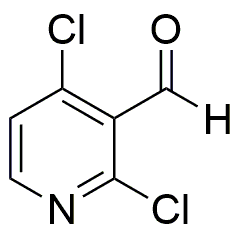2,4-Dichloro-3-pyridinecarboxaldehyde is widely utilized in research focused on:
- Synthesis of Pharmaceuticals: This compound serves as an important intermediate in the synthesis of various pharmaceutical agents, particularly in the development of anti-inflammatory and antimicrobial drugs.
- Agricultural Chemicals: It is used in formulating agrochemicals, including herbicides and fungicides, helping to improve crop yield and protect plants from pests and diseases.
- Research in Organic Chemistry: Researchers use it as a building block in organic synthesis, facilitating the creation of complex molecules for academic and industrial applications.
- Material Science: The compound is explored in the development of new materials, including polymers and coatings, which can enhance durability and performance in various applications.
- Biochemical Studies: It is utilized in biochemical research to study enzyme interactions and metabolic pathways, contributing to advancements in understanding biological processes.
Informations générales
Propriétés
Sécurité et réglementation
Applications
2,4-Dichloro-3-pyridinecarboxaldehyde is widely utilized in research focused on:
- Synthesis of Pharmaceuticals: This compound serves as an important intermediate in the synthesis of various pharmaceutical agents, particularly in the development of anti-inflammatory and antimicrobial drugs.
- Agricultural Chemicals: It is used in formulating agrochemicals, including herbicides and fungicides, helping to improve crop yield and protect plants from pests and diseases.
- Research in Organic Chemistry: Researchers use it as a building block in organic synthesis, facilitating the creation of complex molecules for academic and industrial applications.
- Material Science: The compound is explored in the development of new materials, including polymers and coatings, which can enhance durability and performance in various applications.
- Biochemical Studies: It is utilized in biochemical research to study enzyme interactions and metabolic pathways, contributing to advancements in understanding biological processes.
Documents
Fiches de données de sécurité (FDS)
La FDS fournit des informations de sécurité complètes sur la manipulation, le stockage et l’élimination du produit.
Spécifications du produit (PS)
Le PS fournit une description complète des propriétés du produit, notamment sa composition chimique, son état physique, sa pureté et les exigences de stockage. Il détaille également les plages de qualité acceptables et les applications prévues du produit.
Certificats d'analyse (COA)
Recherchez des certificats d'analyse (COA) en saisissant le numéro de lot du produit. Les numéros de lot et de lot se trouvent sur l'étiquette d'un produit, après les mots « Lot » ou « Lot de fabrication ».
Numéro de catalogue
Numéro de lot/série
Certificats d'origine (COO)
Ce certificat d'exploitation confirme le pays dans lequel le produit a été fabriqué, et détaille également les matériaux et composants utilisés et s'il est issu de sources naturelles, synthétiques ou autres sources spécifiques. Ce certificat peut être requis pour les douanes, le commerce et la conformité réglementaire.
Numéro de catalogue
Numéro de lot/série
Fiches de données de sécurité (FDS)
La FDS fournit des informations de sécurité complètes sur la manipulation, le stockage et l’élimination du produit.
DownloadSpécifications du produit (PS)
Le PS fournit une description complète des propriétés du produit, notamment sa composition chimique, son état physique, sa pureté et les exigences de stockage. Il détaille également les plages de qualité acceptables et les applications prévues du produit.
DownloadCertificats d'analyse (COA)
Recherchez des certificats d'analyse (COA) en saisissant le numéro de lot du produit. Les numéros de lot et de lot se trouvent sur l'étiquette d'un produit, après les mots « Lot » ou « Lot de fabrication ».
Numéro de catalogue
Numéro de lot/série
Certificats d'origine (COO)
Ce certificat d'exploitation confirme le pays dans lequel le produit a été fabriqué, et détaille également les matériaux et composants utilisés et s'il est issu de sources naturelles, synthétiques ou autres sources spécifiques. Ce certificat peut être requis pour les douanes, le commerce et la conformité réglementaire.


